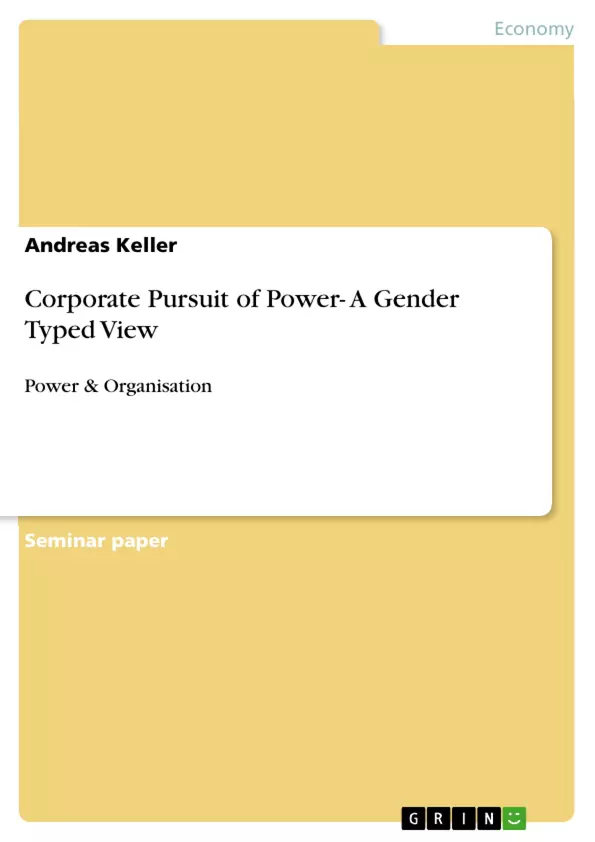Power can be found throughout history in all kinds of organisation. Initially in the ancient world, power within groups, i.e. in clans, was determined by factors closely related to physical strength. Obviously, in today’s societies, corporate structures are derived from other factors. Corporate hierarchies within organisations are establish based on various “unambiguous or explicit” and “unspoken or implicit” criteria such as past success, professional experience and education (unambiguous), or age and political behaviour (unspoken). A study done by McClelland et al. (in Weiss,p.102i) refers to
• Socialized power; used to benefit others and the organisation, and
• Personalised power; only used primarily for one’s own personal gain or benefit.
Without power, people cannot plan or achieve goals, and without varying degrees of power among individuals, it would be impossible to motivate or manage others, mobilise resources or protect individual rights (Weiss,2001,p.234). Empirical research on power also makes a gender distinction, pointing to the different career paths of men and women. Power is, by nature, a rare commodity and beyond the grasp of most women and men, but still it is almost exclusively in the hands of men (Morris, 1994ii).
Inhaltsverzeichnis (Table of Contents)
- Abstract
- Introduction
- Literature Review - Theoretical background
- What is Power?
- Interpersonal Sources of Power
- Power by Gender
- Masculinity vs. Femininity at Work
- Gender-typed Behaviours
- Nonverbal Power - Body Language at Work
- Facial Play
- Gestures
- Paralinguistics
- Discussion
- Personal Learning
- Conclusion
- References
Zielsetzung und Themenschwerpunkte (Objectives and Key Themes)
This paper aims to analyze power dynamics within a corporate setting, focusing on the pursuit of power by gender. It will incorporate both an analytical approach and personal reflections, highlighting the key factors that influence the pursuit of power and authority in a corporate environment.
- The multifaceted nature of power in organizations
- The different sources of interpersonal power
- The impact of gender on power dynamics in the workplace
- The role of nonverbal communication in the pursuit of power
- Personal insights and reflections on power dynamics in organizations
Zusammenfassung der Kapitel (Chapter Summaries)
- Abstract: This chapter provides a brief overview of the paper's focus on power dynamics within corporations, particularly emphasizing the influence of gender on the pursuit of power.
- Introduction: This chapter introduces the concept of power in organizations, highlighting its historical evolution and the various factors that influence its distribution. It emphasizes the importance of power in achieving goals and managing others, and introduces the role of gender in shaping power dynamics.
- Literature Review - Theoretical background: This chapter delves into the theoretical understanding of power. It explores different definitions and dimensions of power, including the influential concept of "organisational power." The chapter then examines the interpersonal sources of power, such as reward, expert, referent, legitimate, and coercive power, providing a comprehensive framework for understanding power dynamics in interpersonal relationships.
- Power by Gender: This chapter examines the impact of gender on power dynamics in the workplace. It explores the influence of societal norms and expectations regarding masculinity and femininity on how individuals navigate power relationships. This section will also delve into the influence of gender-typed behaviors and nonverbal communication in the pursuit of power.
- Discussion: This chapter provides an opportunity to synthesize the information presented in the previous chapters and offer a critical discussion of the key themes. This section might include personal reflections and insights drawn from the research and analysis.
- Personal Learning: This chapter reflects on the personal insights and learnings gained from the research and analysis, further emphasizing the importance of individual perspectives on power dynamics.
Schlüsselwörter (Keywords)
This paper explores the concept of power within corporate structures, particularly examining the pursuit of power through a gendered lens. It delves into theoretical frameworks such as organizational power and the sources of interpersonal power, including reward, expert, referent, legitimate, and coercive power. Additionally, the paper examines the role of gender-typed behaviors and nonverbal communication in influencing power dynamics.
- Quote paper
- MBA Andreas Keller (Author), 2004, Corporate Pursuit of Power- A Gender Typed View, Munich, GRIN Verlag, https://www.grin.com/document/178453



